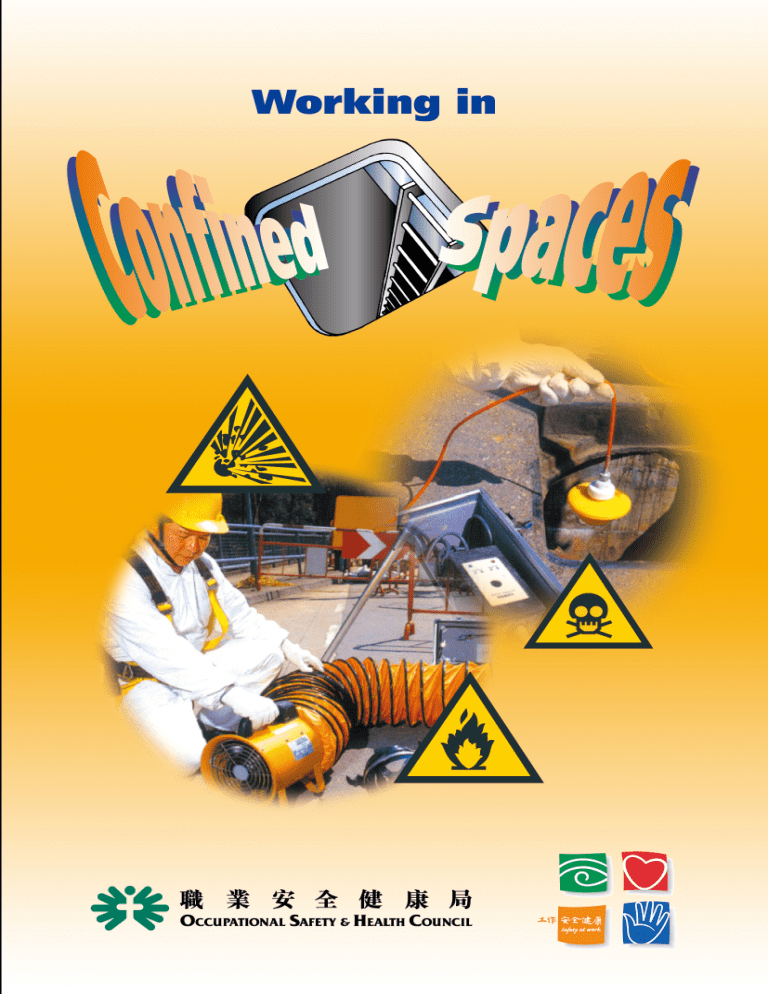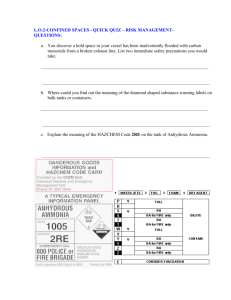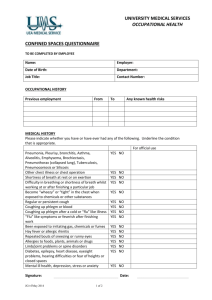
Contents 1. Legal Requirement 1 2. Responsibility of Related Parties 2 3. What are Confined Spaces 3 4. Hazards Identification 4 5. Chemical Substances 6 6. Physical Hazards 7 7. Risk Assessment Report 9 8. Permit-to-work System 10 9. Personal Protective Equipment 11 10. Emergency Plan 12 11. Procedures for Identifying Confined Spaces and Application of Permits for Entry into Confined Spaces 13 12. Procedures for Entry into Confined Spaces 14 *A Chinese version is available 15 Legal Requirement The Factories and Industrial Undertakings (Confined Spaces) Regulation was revised in January 1999 to further protect the safety and health of workers working in confined spaces. The most important change is that the employer has to carry out a risk assessment for work in the confined space, before the worker enters that space for the first time or when the worker is required to enter the space again due to any subsequent changes, so as to formulate a "safe system of work" to protect workers' safety and health. Risk As ses Report sment r ge n Da 1 Responsibility of Related Parties Proprietors or contractors shall: 1. Appoint a competent person to carry out risk assessment when work is to be undertaken in a confined space, and whenever there is any significant change in the conditions of the confined space or of the work therein. 2. Adopt all necessary safety measures and issue certificates in relation to work safety according to recommendations made in the risk assessment report. 3. Allow only certified workers to enter and work in the confined space. The competent person shall: 1. Assess all possible hazards of working in confined spaces. 2. Make recommendations on the safety and health Employers Work Permit measures for workers working in confined spaces. Asse Risk s Rep sment ort 3. Submit reports to proprietors or contractors. Certified Workers Certified workers shall: 1. Observe instructions and attend training. Competent Persons 2. Comply with all safety working procedures formulated. 3. Make full and proper use of any safety equipment or emergency facilities and report any fault or defect in such equipment or facilities immediately. Offenders: 2 Employers Competent Persons Certified Workers Maximum term of imprisonment for 12 months and $200,000 fine Maximum term of imprisonment for 12 months and $200,000 fine Maximum term of imprisonment for 6 months and $50,000 fine What are Confined Spaces A confined space means any place in which, by virtue of its enclosed nature, there arises a reasonably foreseeable specified risk of fire or explosion; loss of consciousness of any person due to an increase in body temperature; loss of consciousness or asphyxiation of any person due to gas, fume, vapour or lack of oxygen; drowning of any person due to an increase in the level of liquid; or asphyxiation of any person who is trapped by a flowing solid. Confined spaces include any chamber, tank, vat, pit, well, sewer, tunnel, pipe, flue, boiler, pressure receiver, hatch, caisson, shaft or silo. 3 Hazards Identification 1. Deficiency of oxygen in air Air generally comprises 21% oxygen. However, in the following conditions, the oxygen in the air may decrease, resulting in a menace with human life: 1. Chemical reactions caused by oxygen consumption: Oxygen is consumed due to oxidation during such processes of welding, cutting by oxy-acetylene, rusting, naked flame operations, fermentation and moulding. 2. Substitution: Oxygen is squeezed out by such inert gases as nitrogen, argon and carbon dioxide. 3. Adsorption on surface: Oxygen is adsorbed by porous surfaces, such as activated carbon. Changes of the oxygen content in air that is breathed in, can cause the following adverse physical reactions to the human body: The oxygen content in air (%) Physical reactions under different oxygen content in air Abundant oxygen content Normal oxygen content Minimum level of oxygen content to ensure safety of the human body Dyspnea, emotional instability, extreme tiredness after activities Fast but weak heartbeat, agitation, dizziness Nausea and vomiting, inability to move freely, semi-unconsciousness Gasping, respiratory arrest, heartbeat stops after a few minutes 4 Hazards Identification 2. Flammable spaces Flammable gas in a confined space can lead to explosion or fire. A space becomes flammable when oxygen in the air mixes with flammable gases, vapours or dust. These gases and vapours may be formed by residues mixed with flammable substances, the use of flammable substances, or chemical reactions (e.g. the formation of methane). The explosive range of flammable gases or vapours (percentage in air) Acetylene Butane Carbon monoxide Hydrogen Hydrogen sulphide Methane Petrol Propane Methylbenzene Trichloroethylene Petroleum solvent Dimethylbenzene Liquefied petroleum gas Town gas A space may also become flammable when combustible dust abounds or flows in the air when disturbed. Dust may come from agricultural products e.g. flour, chemicals, plastic particles, medicine or metal powder. Explosive dust Yellow phosphorus, nylon, wood dust, fine sugar, corn starch, chaff, polycarbonate Flammable spaces will explode when contact with igniting sources such as welding sparks or sparks from portable electrical appliances. 5 Chemical Substances The principal means of encountering chemical substances include respiration, skin absorption and eating. The effects brought by chemical substances upon the human body may be chronic or acute, depending on the period of contact, the intensity of the hazards during contact and the impact of such hazards on health, for example, corrosive, toxic or harmful. Some poisonous gases emit a particular odour, like the smell of a rotten egg for hydrogen sulphide; whereas some toxic gases are odourless, like carbon monoxide, which is both colourless and odourless. In addition, the unpleasant smell of some toxic gases like hydrogen sulphide is likely to anaesthetise one's sense of smell soon after contact so that one may no longer sense its existence. Therefore, only the use of scientific equipment is reliable to measure the existence of chemical. Respiration Eating Skin absorption 6 Physical Hazards 1. Mechanical hazards Some dangerous components such as belts, rotation shafts and gears in equipment may cause harm when used. 2. Electrical hazards The risk of death caused by electric shock or getting burnt may arise when touching electric cables, electric wires and transformers in confined spaces or using electrical appliances in wet spaces. 3. Noise hazards Noise produced when working in confined spaces is generally higher than normal, leading to impairment in workers' hearing and may even lead to deafness. 4. Radiation hazards Sparks produced when using radioactive equipment in confined spaces may cause harm, such as laser or welding sparks. 5. Environmental hazards The following environmental conditions are more likely to pose danger in confined spaces: • extremely high or low temperature • dampness • wet spaces 6. Transportational hazards Since the entrance and exit of some confined spaces, such as sewers, are situated on pavements or roads, workers will have the risk of being knocked down by vehicles passing by. There is also risk of people falling down into the confined spaces. 7 Physical Hazards 7. Engulfment by liquid or flowing solids The risk of drowning arises when the confined space is waterlogged or when water or other liquid suddenly pours in. In addition, flowing solids such as silt or cereals may pose the risk of engulfment. A bridge-shape crust of cereals Void Victims may be engulfed by flowing solids Cereals in unstable bridge-shapes may form when some of the materials are extracted from a silo Other Hazards 1. Hazards from manual operations The working environment of confined spaces is generally narrow and workers inside need considerable effort when performing manual operations. The use of personal protective equipment may also increase the difficulty of performing manual operations. 2. Biological hazards Workers may be infected with different varieties of bacteria and viruses and even threatened by biological hazards produced by insects and snakes. 8 Risk Assessment Report Risk assessment is a procedure of identifying the relevant hazards and exploring the possibility of inflicting injuries upon, and causing diseases to, the relevant worker. Employers shall conduct a risk assessment for each hazard identified, including the chance of encountering such hazards by any person, the extent of impact, and the effectiveness of the existing measures for controlling risks. Persons appointed for conducting risk assessments should determine the appropriate method of assessment and carry out a site inspection in the confined space. Risk assessments should take into account the following main factors: Location of the confined space. Classification of the confined space. The exit route and the relevant emergency escape procedures. Possible dangers caused by works to be performed outside the confined space. The possibility of any change in the oxygen content in the air and the existence of flammable, explosive or toxic gases. The structure and size of the confined space. For example, operation of the worker or equipment may be restrained if the work space is too narrow. Stability and the possibility of sudden movements. The source of illumination, electricity and source of energy inside the confined space. 9 Permit-to-work Certificate Whenever workers enter a confined space, a permit-to-work certificate should be issued beforehand. This permit is only valid for working in one particular confined space. Any person who is going to enter and work in a confined space should apply for a permitto-work certificate with any responsible party who is authorised to issue such permit. The permit should set out all the tools permitted and forbidden for use and the provisions for work implementation. Before issuing a permit-to-work certificate, the person responsible should ensure that the air inside the work place has reached a safe level, which should be maintained during work in progress. No danger should arise and other measures of risk control should be completed effectively. Permit-to-work certificates should be issued on an individual basis. When the time for completion as stipulated in the permit is over, workers must leave the confined space. If extra time is needed for work, a new certificate should be applied instead. Permit-to-work certificates and risk assessment reports should be displayed in a conspicuous space within the immediate vicinity of the confined space for workers' reference. Risk Assessment Report 10 Permit-to-work Certificate Personal Protective Equipment Personal protective equipment serves as the last resort for controlling hazards and is one, but not the only, ancillary or temporary measure. To make full and proper use of personal protective equipment, one should first make sure that the equipment can fulfil the working requirements, conform to the required standards, fit the body shape of the user, be user-friendly, and is under regular maintenance and can be replaced if necessary. Safety helmet Goggles, visor Safety helmets protect the head of the wearer from injuries caused by falling or wavering objects. Goggles and visors protect the eyes of the wearer from injuries caused by strong light or flying objects. Earmuffs, earplugs Earmuffs and earplugs protect the ears of the wearer from injuries by loud noises. Safety boots Safety boots protect the feet of the wearer from injuries, puncture wounds and slipping. Respirator Safety belt Safety harnesses protect workers from falling from heights. Respirators protect the respiratory system of the wearer from the attack of poisonous gases, fumes, mist and dust. Mask-type respirators can block dust. While filter-type respirators can absorb vapour emitted from chemicals, and air-supplied respirators can supply pure air to sustain life when the atmosphere is filled with poisonous gases or in times of oxygen deficiency. 11 Emergency Plan Emergency procedures should be formulated and a contingency team should be formed. Team members should receive training and perform drills regularly. Emergency devices generally used include: • approved breathing apparatus • resuscitators • oxygen cylinders or compressed air bottles • safety harnesses and ropes • audio and visual alarms for giving warning signals to people outside the confined space • first-aid box • lifebuoys tied with ropes (if operation is carried out along the shore) Safety equipment for confined spaces Tripod and fall arrestor Full-body harness Air blower (explosion-proof) Movable fences Traffic cone, sign board Toxic gas meter (explosion-proof) Life line Stretcher Communicator (explosion-proof) Breathing apparatus 12 Resuscitator First-aid box Head lamp, torch (explosion-proof) Safety boots Procedures for Identifying Confined Spaces and Application of Permits for Entry into Confined Spaces 13 Procedures for Entry into Confined Spaces 14

